





(This article was originally published on January 1, 2008. Your comments are welcome, but please be aware that authors of previously published articles may not be able to respond to your questions and comments.)
My experience with the perils of non-draining plant pots came as a result of hauling away thousands of plants as "cull packs" from a big box store in my area. These plants were so completely distressed that no one (in their right mind) would buy them at even deeply discounted prices. I picked them up for a few pennies on the dollar for each plant and nursed those back to health that were salvageable. Most often, when plants were in decorative containers for seasonal sales, I would literally dump gallons of water out of the containers before I could load the plants into my van.
In December and at other holiday times (Mother's Day, Easter, Valentine's Day) when live plants are frequently presented as gifts or intended for use as indoor accessories, the plants will often come in decorative foil wrap, plastic or metal tins, glazed pots, or some other container that doesn't allow water to drain. This is a "good thing," as Martha Stewart might say, to prevent water damage to tables, carpets, or furniture in the vicinity of where the plant will be displayed. It is, however, the most likely cause of death in plants provided as holiday gifts or purchased for interior decoration.
Most garden center store personnel, especially in the big box stores, can't take the time to drain each decorative container after watering the plants. In many large retail garden centers, the plants are generally over-watered while on display. When a deluge of water is combined with a decorative container with no drainage, the situation becomes quickly critical. Few plants, except for water lilies and other aquatics, want their roots sitting in water for any prolonged time. In order for nutrient and fluid uptake to occur, there has to be a capillary (siphon, soda straw-like) movement going on in the stems in both directions between the leaves and the roots. If the plant roots are waterlogged with no tiny air spaces for ionic exchange to occur, the capillary action is halted. The plant can't take up nutrients, the cells of the leaves and stems become engorged with water, the leaf pores swell shut, and only a minimal amount of transpiration can occur. Roots will quickly rot in the stagnant water, most often to the point of the plant being beyond recovery.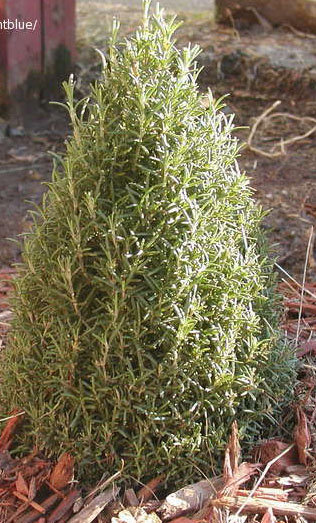 Oddly, plants will often exhibit signs of wilting when over-watered much like the wilting that occurs when they are too dry. The natural instinct for the untrained plant tender upon seeing a plant in a state of wilt is to dump on more water, further exacerbating the problem if the plant is already soaked.
Oddly, plants will often exhibit signs of wilting when over-watered much like the wilting that occurs when they are too dry. The natural instinct for the untrained plant tender upon seeing a plant in a state of wilt is to dump on more water, further exacerbating the problem if the plant is already soaked.
Over-watering causes damage especially fast in rosemary plants (Rosmarinus officinalis). You will see beautiful rosemary topiaries at holiday time, pruned into conical Christmas tree shapes, or espaliered onto wire wreaths. Nearly always, these coiffed creations come with an attractive, non-draining container. It only takes a day or two for a rosemary plant to die from standing in water. Once the damage has occurred, there will be little chance for the rosemary to recuperate. The ill effects may not be immediately apparent when the plant is purchased. In some of the cull pack hauls I made at Christmastime 2006, there were a few dozen two-foot tall rosemary topiaries that were still green and fragrant. They appeared healthy other than showing signs of some wilting and turning brown at the stem tips. All of the rosemary topiaries were standing in water in their containers when they came to me. Despite my best efforts, none of them survived.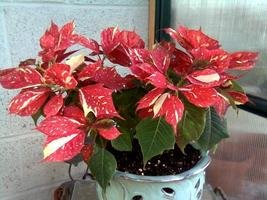
Poinsettias, also, will succumb rather quickly to over-watering. They have a better survival rate if the problem is determined before the damage has progressed to the fatal state. With both rosemary and poinsettias, it is best to err on the side of keeping the plant too dry, especially when indoors, rather than over-watering them. The University of Florida is a major center for poinsettia research. The school has a superlative trial program for newly introduced poinsettia cultivars, and an extensive selection of poinsettias offered for sale each November. I had the privilege of touring the university poinsettia greenhouses as part of my Master Gardener training. The best information I've come across for tending to poinsettias while they are indoors and keeping them alive and blooming for seasons to come is found in one of the university publications: "Poinsettias for Florida: Indoors and Out". You will find there a detailed history of the poinsettia and complete instructions for the care of your plant. Most of the information will apply whether or not you live in Florida.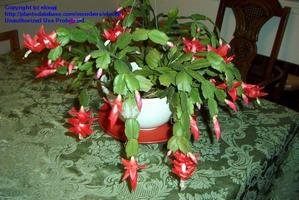 Christmas Cactus (Schlumbergera x buckleyi - often referred to as Zygocactus) does not require frequent watering when in a container indoors. If they are over-watered or left standing in water, rot and fungal infections will occur at the root crown (where the stems attach to the roots at soil level). The leaf segments will break away from the soil and will become shriveled. Fortunately, new plants can be propagated from remaining leaf segments even if the root crown is rotted. But then, you will end up with small starts of plants rather than the full beauty you purchased or received as a gift (possibly at a price of about $40 for a plant in a six inch container, from what I've seen in the past few weeks). To check the moisture level of your Christmas Cactus, carefully work your fingertip down into the soil to make sure it is fairly dry before adding water.
Christmas Cactus (Schlumbergera x buckleyi - often referred to as Zygocactus) does not require frequent watering when in a container indoors. If they are over-watered or left standing in water, rot and fungal infections will occur at the root crown (where the stems attach to the roots at soil level). The leaf segments will break away from the soil and will become shriveled. Fortunately, new plants can be propagated from remaining leaf segments even if the root crown is rotted. But then, you will end up with small starts of plants rather than the full beauty you purchased or received as a gift (possibly at a price of about $40 for a plant in a six inch container, from what I've seen in the past few weeks). To check the moisture level of your Christmas Cactus, carefully work your fingertip down into the soil to make sure it is fairly dry before adding water.
The potted, forced spring bulbs (amaryllis, tulips, daffodils, crocus, Paperwhites, Easter lilie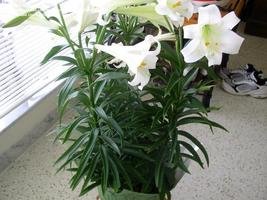 s, and even Asiatic lilies) also often come in bright foil wrap. If you are buying these for a one-time decorative purpose, then over-watering while in the store probably won't matter much. However, if you intend to plant the bulbs in your garden for returning blooms from year-to-year, then you will want to make sure the bulbs are firm and intact.
s, and even Asiatic lilies) also often come in bright foil wrap. If you are buying these for a one-time decorative purpose, then over-watering while in the store probably won't matter much. However, if you intend to plant the bulbs in your garden for returning blooms from year-to-year, then you will want to make sure the bulbs are firm and intact.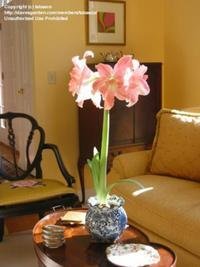 I now have a perimeter row of about fifty Easter Lilies (Lilium longiflorum) at the back border of my front yard garden. The lilies bloom dependably every year -- not exactly at Easter time, but a few weeks later. I got most of the bulbs for a few dollars each after they were out of bloom. I am always disappointed when the purchased lily pot contains a fetid, yellow ball of mush where once was a nice, scaly bulb. The culprit for the bulb's demise was over-watering combined with a watertight foil wrap prior to my purchasing the bulb. If you are buying potted, out-of-flower bulbs, even at bargain prices, to transplant to your garden, take a moment to stick your fingers deep enough into the potting soil to squeeze the bulbs near their roots to determine if the bulbs are healthy. They should have the firmness of a fresh onion bulb and not be spongy.
I now have a perimeter row of about fifty Easter Lilies (Lilium longiflorum) at the back border of my front yard garden. The lilies bloom dependably every year -- not exactly at Easter time, but a few weeks later. I got most of the bulbs for a few dollars each after they were out of bloom. I am always disappointed when the purchased lily pot contains a fetid, yellow ball of mush where once was a nice, scaly bulb. The culprit for the bulb's demise was over-watering combined with a watertight foil wrap prior to my purchasing the bulb. If you are buying potted, out-of-flower bulbs, even at bargain prices, to transplant to your garden, take a moment to stick your fingers deep enough into the potting soil to squeeze the bulbs near their roots to determine if the bulbs are healthy. They should have the firmness of a fresh onion bulb and not be spongy.
 Perhaps it may only occur in my sub-tropical jungle-like climate, but I would advise caution if leaving bulbs in pots for very long outdoors. I allowed a few hundred tulip bulbs in pots from the cull pack hauls to go through their natural cycle of growing until the heat killed back their leaves. Once they reached dormancy, I intended to harvest the bulbs and ship them to Dave's Garden subscribers further north that might be able to get the tulips to rebloom (tulips are a single, very short season splash of color in my Zone 8b/9a garden). When it came time to take the tulip bulbs out of their pots, I found that the omnipresent termites had determined the tulip bulbs were an exotic, chewy Dutch delicacy. There was nothing left in the potting soil other than slimy tulip bulb residue and fat, grinning termites.
Perhaps it may only occur in my sub-tropical jungle-like climate, but I would advise caution if leaving bulbs in pots for very long outdoors. I allowed a few hundred tulip bulbs in pots from the cull pack hauls to go through their natural cycle of growing until the heat killed back their leaves. Once they reached dormancy, I intended to harvest the bulbs and ship them to Dave's Garden subscribers further north that might be able to get the tulips to rebloom (tulips are a single, very short season splash of color in my Zone 8b/9a garden). When it came time to take the tulip bulbs out of their pots, I found that the omnipresent termites had determined the tulip bulbs were an exotic, chewy Dutch delicacy. There was nothing left in the potting soil other than slimy tulip bulb residue and fat, grinning termites.
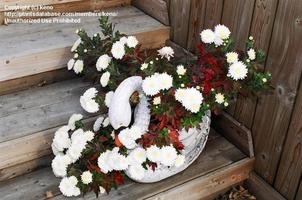
Chrysanthemums, too, will suffer from sitting in water in decorative containers. Many of them will recover if you can get them to dry out before rot or fungus destroys the roots. In my sub-tropical climate, I have several "reclaimed" chrysanthemum bushes. They generally all but disappear in the heat of summer and autumn, but return to green up and bloom in the cool months from December through March.
Hydrangeas will wilt when they are over-watered. They might make you think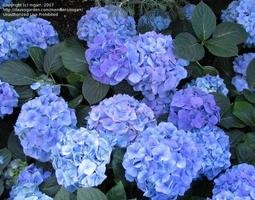 they are completely dried up when they actually are drowning. For hydrangeas, it is best, if possible, to keep the soil consistently moist without being soggy. If you notice leaves drooping, feel the soil to determine if it is too wet or too dry prior to adding more water. To be on the safe side, you may want to wait a day or two before dragging out the watering can. If the hydrangea has been over-watered and it is receiving sufficient sunlight, you should see some improvement with the leaves becoming more upright as the soil dries out. If your hydrangea happens to drop all its leaves (from over-watering, drying out, freezing temperatures outdoors, or lack of humidity while indoors), don't give up total hope. Hydrangeas will often regenerate from the root crown or grow new leaves along the lower portions of their stems. Even after severe stress, once hydrangeas are returned to optimum conditions of diffused bright sunlight, appropriate and consistent watering, and ample humidity, they will often rebound to complete health.
they are completely dried up when they actually are drowning. For hydrangeas, it is best, if possible, to keep the soil consistently moist without being soggy. If you notice leaves drooping, feel the soil to determine if it is too wet or too dry prior to adding more water. To be on the safe side, you may want to wait a day or two before dragging out the watering can. If the hydrangea has been over-watered and it is receiving sufficient sunlight, you should see some improvement with the leaves becoming more upright as the soil dries out. If your hydrangea happens to drop all its leaves (from over-watering, drying out, freezing temperatures outdoors, or lack of humidity while indoors), don't give up total hope. Hydrangeas will often regenerate from the root crown or grow new leaves along the lower portions of their stems. Even after severe stress, once hydrangeas are returned to optimum conditions of diffused bright sunlight, appropriate and consistent watering, and ample humidity, they will often rebound to complete health.
My most recent experience of planting hydrangeas was followed soon afterwards by about twenty-three inches of rain in two days. I learned from this event that our native Oak Leaf Hydrangea (Hydrangea quercifolia) is especially susceptible to damage from being waterlogged. Oak Leaf Hydrangea are unlikely to recover if their roots are standing in water for even a few days. I lost several of them due to their being planted in soil with poor drainage and the sudden downpour of rain. The Hydrangea macrophylla and H. paniculata cultivars that I planted at the same time were apparently a bit more forgiving of being flooded for short durations.
Even expensive orchid plants are mistreated in many garden center store displays. I found that most of the orchid plants I got in the cull packs came with their rhizomes firmly encased in sphagnum peat moss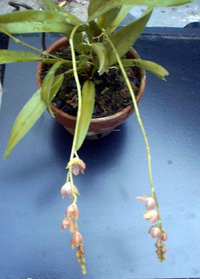 (the greenish, mossy, fibrous type -- not the dry, brown peat moss used as a soil amendment). I'm guessing that the orchid growers and suppliers use sphagnum to make the live orchid plants easier to transport. The typical, loose orchid bark that is the appropriate growing medium for most orchids is very likely to spill out of the pot, along with the orchid plant, during delivery to the store. Compressed sphagnum holds the plant securely in place, but it also retains too much water unless it is expertly monitored.
(the greenish, mossy, fibrous type -- not the dry, brown peat moss used as a soil amendment). I'm guessing that the orchid growers and suppliers use sphagnum to make the live orchid plants easier to transport. The typical, loose orchid bark that is the appropriate growing medium for most orchids is very likely to spill out of the pot, along with the orchid plant, during delivery to the store. Compressed sphagnum holds the plant securely in place, but it also retains too much water unless it is expertly monitored.
Orchids are often presented for purchase in attractive, but inappropriate, containers such as ornate glazed pots with permanently attached saucers or non-draining, fancy jardinières. Despite their delicate flowers, orchids are amazingly resilient plants. My first act of resuscitation when I brought home cull pack orchids was to gingerly tease the sphagnum away from whatever remained of the rhizomes. A healthy orchid rhizome should look something like a stiff, but somewhat flexible, white, thin worm, generally with a bright green tip -- which is the point where most of the orchid's nutrients are absorbed from moist air particles. If the rhizomes are flaccid, brown and thin, it is a sign of over-watering or under-watering. The orchid will often recover if it is situated in diffused, bright light and placed in an appropriate orchid growing soil mix in a fast-draining pot (clay pots for orchids have extra long slits down the sides to facilitate good, quick drainage). I've brought home some orchids that were so abused that nothing remained of the plant except the root crown and one or two reasonably healthy rhizomes. After removing the sphagnum, repotting with orchid bark mix, and careful watering, the orchids would often come back from the brink of death and grow new leaves. With patient tending, many of them would eventually flower (as did the diminuitive Howeara, pictured above).
In bright light, indoor heat, and low humidity, orchid plants may need watering two to three times per week. Water early in the morning (orchids don't like wet toes at night --they get fungal infections easily in warm, moist night air). It is preferable to hang orchid plants so that the bark mix can more easily dry in the ambient air. In any case, be sure to drain your orchid plants completely before returning them to a decorative container. As with other plants mentioned above, less water is far better than too much water.
The "mini-plants" [cacti, succulents, and some of the terrarium-sized ornamental plants, such as miniature Peace Lilies (Spathiphyllum sp.), in four-inch pots or smaller] are another plant series where I foun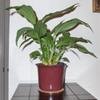 d over-watering in non-draining containers was the most frequent reason the plants ended up coming to me comatose in the cull packs. These plants are typically planted in a small, thin plastic pot that is then inserted into a decorative pot with a snap-on, removable plastic saucer. This arrangement is fine for an experienced gardener attentive to when the plant actually needs water. Unfortunately, the tendency in most large garden centers is to hose everything down equally, regardless of the particular water needs of an individual plant at any given time. The decorative plastic containers with saucers hold water continuously rather than allowing the plants to go through a natural cycle of drying out before being watered again. I found that when I got these plants home, if I would immediately remove the inner pot from the decorative pot and saucer, I could most often get the plants to recover, depending on the species and the degree of stress the plant had endured. Miniature ferns seem especially determined to survive. I've had them surprise me by emerging from the soil line of their pots several months after I had nearly given up hope on them.
d over-watering in non-draining containers was the most frequent reason the plants ended up coming to me comatose in the cull packs. These plants are typically planted in a small, thin plastic pot that is then inserted into a decorative pot with a snap-on, removable plastic saucer. This arrangement is fine for an experienced gardener attentive to when the plant actually needs water. Unfortunately, the tendency in most large garden centers is to hose everything down equally, regardless of the particular water needs of an individual plant at any given time. The decorative plastic containers with saucers hold water continuously rather than allowing the plants to go through a natural cycle of drying out before being watered again. I found that when I got these plants home, if I would immediately remove the inner pot from the decorative pot and saucer, I could most often get the plants to recover, depending on the species and the degree of stress the plant had endured. Miniature ferns seem especially determined to survive. I've had them surprise me by emerging from the soil line of their pots several months after I had nearly given up hope on them.
So, my advice, offered as someone deeply committed to plant rescue and wanting every plant to have a fair chance at a healthy life: before purchasing any live plant in a watertight container, pull the plant pot out of the foil wrap or decorative container to see if there is standing water in the outer container. If there is water present, it may be best to pass the plant up and seek out a garden center with a more conscientious and plant-friendly watering routine.
If you happen to be presented with a live plant in a decorative container as a gift, smile politely, accept it graciously, hug it and the presenter tenderly and appropriately; but as soon as the donor leaves, check the water level in the outer container! If the plant has been standing in water, allow it to drain completely.
If you love the look of the decorative container, or want to keep the plant in the container to avoid water damage to interior furnishings, you can be kind to your plant by taking the plant out of the container before you water the plant. Soak the soil thoroughly, and then wait for the excess water to drain out of the plant's pot before putting it back into the decorative container. I usually do this sort of watering at my kitchen sink. I leave the plant pot over the sink drain for approximately thirty minutes to an hour so the water can flow out freely. After returning the plant to the decorative container, check the plant frequently to make sure there is no standing water.
I find it best with all my plants, indoors and in the garden, to set up a regular routine of irrigating my plants. For potted plants, I add water until some water begins to seep out of the bottom of the pot. This is best done perhaps once a week (more, or less, as needed, depending on the climatic conditions and plant species). Wait until the next week to soak the plant again. This provides a more natural cycle for the plant to absorb water, dry out partially, and then regain moisture much as it might in its native habitat. Watering piecemeal, from time to time, when I happen to think about it, can lead to disaster. Since I'm likely to forget when I last watered my plants, I have selected a day (my self-imposed weekly watering time is Sunday afternoon) and I stick to the schedule, adjusting the amount of water each plant gets as I become more familiar with its needs during each passing season. It's also easier to remember to fertilize with the recommended dilute solution (half strength or less) when following a set schedule. Some potted plants, especially those in hanging baskets, may require more frequent watering. I still try to maintain a regular schedule rather than watering as a reaction to visible stress in the plant.
Most homes lack humidity in the artificial heat of wintertime. You may be amazed at how quickly a tray of gravel with water in it will dry up indoors in a heated house, even in a relatively cool room. Providing a tray of moist gravel beneath your plants, with the plant pots raised slightly so as not to be continually sitting in the water, will create a more humid environment. This is favorable for most indoor plants (and humans and pets, too!). Grouping similar plants together will create a microclimate of increased humidity. You might also consider running a humidifier in the room where most of your plants are kept, or put them in a bathroom near a bright window, and let the evaporative steam and humidity from your showers and other water usage help keep your plants fresh and happy.
I've had success with using a typical thirty-gallon plastic storage container as a mini-greenhouse for indoor plants. Cap the storage container upside down over a tray of wet gravel with small tropical plants, Epi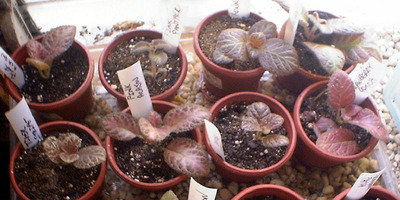 scias, or even African Violets (Saintpaulia sp.) beneath it. Place it near a window with filtered south light. The humidity stays high inside the container and the g
scias, or even African Violets (Saintpaulia sp.) beneath it. Place it near a window with filtered south light. The humidity stays high inside the container and the g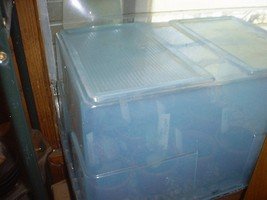 ravel tray doesn't need refilling with water as often. This method also provides a barrier for curious kittens, small children, or other noxious pests that might upset the plants. The cover can be removed quickly when company comes in order to show off your prized plants to their best advantage.
ravel tray doesn't need refilling with water as often. This method also provides a barrier for curious kittens, small children, or other noxious pests that might upset the plants. The cover can be removed quickly when company comes in order to show off your prized plants to their best advantage.
Tending to plants in the unnatural condition of generally reduced light indoors in winter and the rigors of home heat with the accompanying lack of humidity can be a challenging ordeal for you and your plants. Placing plants in standing water in a non-draining decorative container is likely to be a death sentence for them. But, if your plants are tended with a bit of loving devotion and a sensitivity for the needs of each individual plant, the result can be delightful foliage and floral tributes that may last for many seasons, and bring beauty and joy for more Happy Holidays to come!
(Your comments are welcome! Start a thread, or provide a comment to an existing thread, below.)
A tip to "read more about it" -- Did you know Dave's Garden now has a search feature for Discussion Forums and previously published Articles? To search previous Articles, click on "Guides and Information," click on "Articles" at the top of the far right column, then in the top right corner, type in the key words for the plant or topic you want to investigate. To see what discussions have occurred in Forums about the plant or topic, click on "Communities," click on "Discussion Forums," then in the top right corner, type in the key words you want to investigate. In the previous Articles, especially, you will find more detailed information about some of the seasonal plants discussed above. Happy Gardening!
Copyright © www.100flowers.win Botanic Garden All Rights Reserved